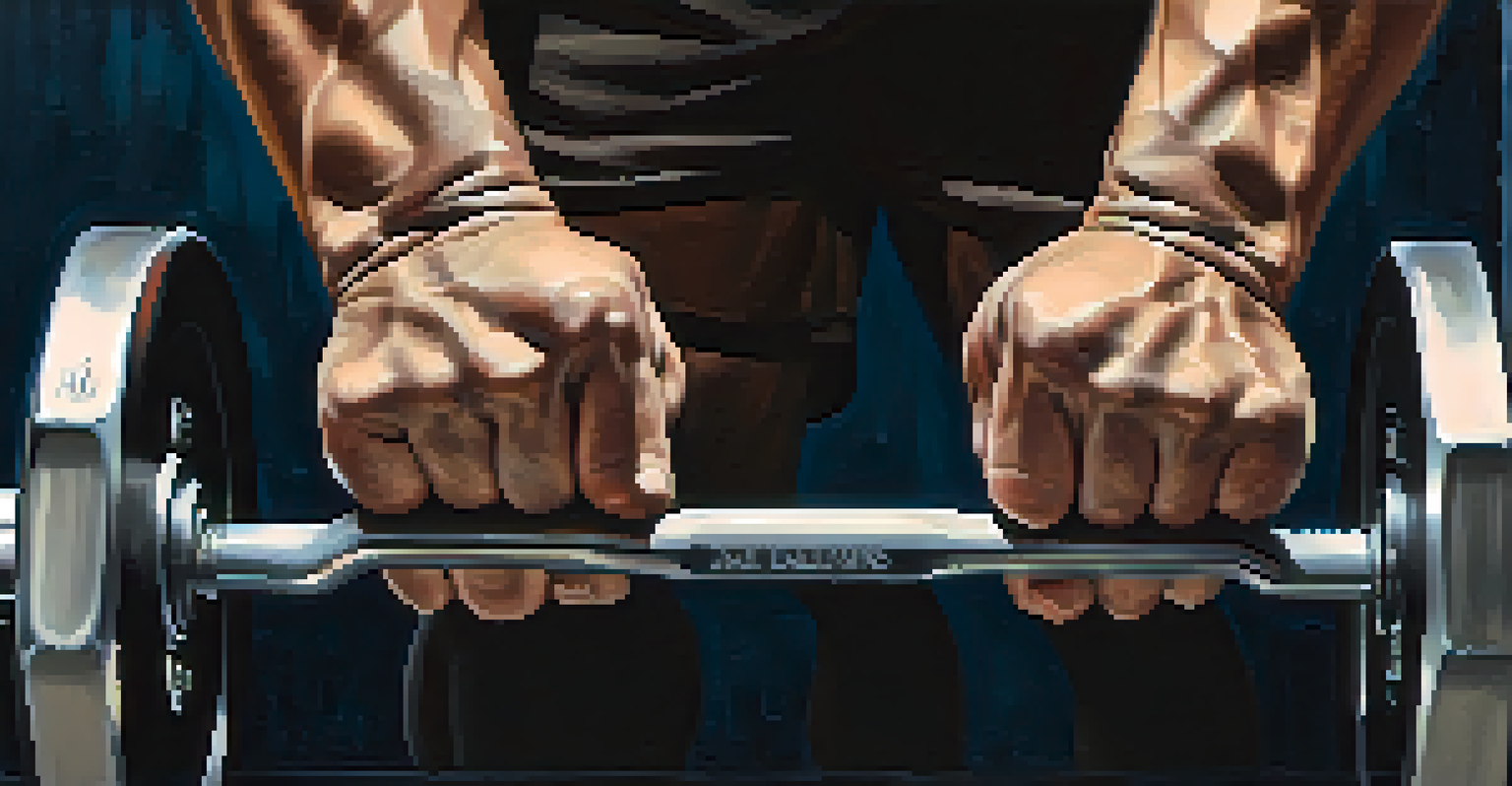The Role of Technique in Powerlifting Safety Protocols

Understanding Powerlifting: A Brief Overview
Powerlifting is a strength sport focused on three main lifts: the squat, bench press, and deadlift. Each of these lifts requires not only raw strength but also precise technique to ensure maximum effectiveness and safety. Many new lifters may overlook the importance of technique, thinking that heavier weights alone will yield better results.
Strength does not come from physical capacity. It comes from an indomitable will.
However, technique serves as the foundation upon which strength is built. It's not just about lifting weights; it's about how you lift them. Proper technique minimizes the risk of injury, allowing lifters to progress safely and effectively.
For instance, consider the squat. A lifter who squats with improper form may put undue stress on their knees and back, leading to potential injuries. By understanding the mechanics involved and practicing correct technique, lifters can avoid these pitfalls and enjoy a long, successful powerlifting career.
The Connection Between Technique and Injury Prevention
Injuries in powerlifting are often a result of poor technique rather than a lack of strength. When lifters use improper form, they place excessive strain on their muscles and joints, which can lead to long-term damage. This is why mastering technique is crucial for anyone looking to lift heavy safely.

For example, in the deadlift, maintaining a neutral spine is critical. If a lifter rounds their back while lifting, it can result in serious spinal injuries. By focusing on correct posture and movement patterns, lifters can significantly reduce their risk of injury.
Technique Prevents Injuries
Mastering proper lifting technique is essential for minimizing injury risks and ensuring long-term success in powerlifting.
Additionally, training with proper technique allows lifters to build strength more efficiently. As they become more familiar with the correct movements, they can lift heavier weights with greater confidence and security, leading to improved performance over time.
The Role of Coaching in Developing Technique
Having a knowledgeable coach can make all the difference in mastering powerlifting techniques. Coaches can provide real-time feedback, helping lifters identify and correct mistakes before they become habits. This personalized guidance can accelerate the learning process and enhance safety.
The difference between a successful person and others is not a lack of strength, not a lack of knowledge, but rather a lack in will.
For instance, a coach may observe a lifter's squat and notice that their knees are caving in. By addressing this issue, the coach can help the lifter adjust their stance and improve their form, ultimately preventing potential injuries.
Moreover, coaches can design training programs that focus on technique drills, ensuring that lifters develop a strong foundation. This commitment to proper technique not only enhances safety but also fosters a more enjoyable lifting experience.
Warm-Up and Mobility: Essential Elements of Safety
Before any powerlifting session, a proper warm-up is crucial to prepare the body for heavy lifting. A good warm-up increases blood flow to the muscles, enhances flexibility, and reduces the risk of injury. Incorporating mobility exercises can further improve range of motion and overall performance.
For example, dynamic stretches targeting the hips, shoulders, and legs can help lifters achieve better positioning during their lifts. This not only enhances technique but also promotes safety by ensuring that the muscles are ready to handle the demands of powerlifting.
Coaching Enhances Performance
Having a knowledgeable coach can provide valuable feedback and personalized guidance, accelerating the development of safe and effective lifting techniques.
Additionally, a well-planned warm-up routine can serve as a mental preparation, allowing lifters to focus and mentally prepare for the challenges ahead. By prioritizing these elements, lifters can create a safer and more effective training environment.
Listening to Your Body: Key to Sustainable Lifting
One of the most important aspects of safety in powerlifting is learning to listen to your body. Discomfort is a natural part of lifting, but pain can signal that something is wrong. Recognizing the difference between the two is essential for long-term success and safety.
For instance, if a lifter feels sharp pain during a lift, it’s a clear indication to stop and reassess their technique or take a break. Ignoring these signals can lead to serious injuries that could sideline a lifter for months or even years.
By tuning into their bodies, lifters can make informed decisions about their training and avoid pushing through pain. This awareness not only helps maintain safety but also fosters a healthier relationship with lifting.
Progression: Gradual Increases for Safety
When it comes to powerlifting, the principle of progression is key. Lifters should gradually increase their weights to allow their bodies to adapt to the stresses being placed on them. Jumping into heavy weights too quickly often leads to poor technique and increased risk of injury.
For example, a lifter might start with lighter weights to master their form before attempting heavier lifts. This gradual approach helps develop strength while reinforcing proper technique, ensuring that the lifter is prepared for the challenges ahead.
Gradual Progress Ensures Safety
Implementing a gradual approach to weight increases allows lifters to adapt safely while reinforcing proper form and technique.
Moreover, tracking progress can help lifters recognize when it's time to increase their weights safely. By being patient and understanding that strength gains take time, they can build a solid foundation for future success.
The Lifelong Benefits of Safe Powerlifting Practices
Prioritizing technique and safety in powerlifting not only benefits performance in the short term but also promotes lifelong health. Lifters who focus on proper form and injury prevention are more likely to enjoy their training for years to come. This longevity can lead to a deeper passion for the sport.
Furthermore, developing safe lifting habits early on sets the stage for future success. Lifters who prioritize technique are more likely to excel and achieve their goals without the setbacks that injuries can cause.

Ultimately, making safety a top priority in powerlifting creates a sustainable practice that allows individuals to enjoy the physical and mental benefits of the sport for years to come. It’s about building strength responsibly and cherishing the journey.